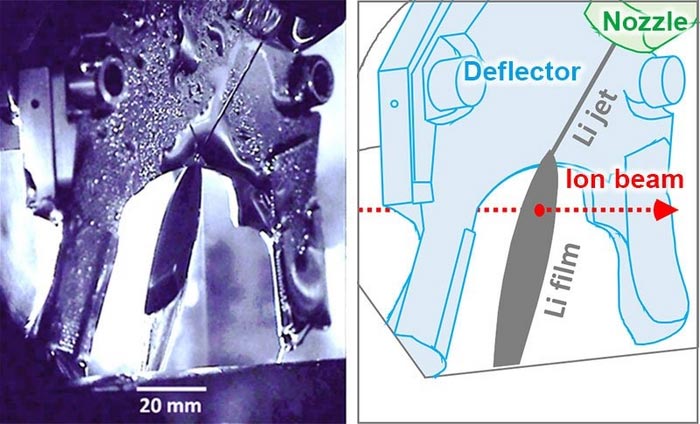
Liquid-Lithium Charge Stripper Enhances Heavy-Ion Acceleration

Left: Photograph of the liquid-lithium film formed in the FRIB beamline chamber. The extremely smooth surface of the lithium film appeared as a mirror. Right: Corresponding illustration with labels for clarity.
Image courtesy of the Facility for Rare Isotope Beams
The Facility for Rare Isotope Beams has demonstrated an innovative liquid-lithium charge stripper to accelerate unprecedentedly high-power heavy-ion beams.
The Science
The Facility for Rare Isotope Beams (FRIB) accelerates heavy-ion beams at beam power up to 400 kilowatts into a target to create rare isotopes for scientific research. A charge stripper plays an essential role in this process. It strips additional electrons from the charged-particle beam to accelerate it more efficiently. FRIB’s beam is too powerful for a conventional charge stripper made of carbon foil. This type of charge stripper would suffer severe thermal and radiation damages, limiting its lifetime and beam power. To overcome this, FRIB developed and demonstrated a state-of-the-art liquid-lithium charge stripper. Since it is self-replenishing, this new charge stripper is a superior heat remover and cannot be damaged by radiation.
The Impact
Scientists considered two alternative designs when designing FRIB’s charge stripper. Even the best-performing carbon-foil charge stripper would only last for six hours at FRIB. Another type of self-replenishing charge stripper is a gas stripper. While this can last indefinitely, the beam’s charge state after the gas charge stripper is significantly lower than after a solid or a liquid charge stripper. The charge state of the ion equals the number of electrons removed from a neutral atom. The higher the charge state, the more acceleration the accelerator can provide to the ion. A liquid-lithium charge stripper has a double advantage: It can produce as high a charge state as a solid charge stripper and last indefinitely. This new technology will help FRIB accelerate heavy-ion beams up to 400 kilowatts, and open new possibilities in various other high-power accelerator developments.
Summary
High-power, heavy-ion beam facilities like FRIB are needed to enable fundamental nuclear science discoveries. FRIB enables scientists to study properties of rare isotopes, nuclear astrophysics, fundamental interactions, and applications for society, including in medicine, homeland security, and industry. In such accelerators, charge strippers play an essential role in effectively accelerating the beams. However, the conventional carbon stripper is the bottleneck, limiting beam power. In this research, a liquid lithium film with a thickness of 10–20 micrometers (about one-tenth the thickness of a human hair), flowing at more than 50 meters per second (180 kilometers per hour or 112 miles per hour) was stably formed in the accelerator beamline at FRIB, a Department of Energy (DOE) Office of Science user facility at Michigan State University. Xenon, argon, and uranium beams were applied to the film, and its stability and stripping capability were measured. The results showed the lithium film was an effective heavy-ion stripper even with the uranium beam. Together with the success of an earlier high-power demonstration experiment at DOE’s Argonne National Laboratory, the research showed for the first time that the liquid-lithium charge stripper can significantly increase the accelerator power beyond the present limit.
Funding
This work was supported by the DOE Office of Science, Office of Nuclear Physics and used resources of the FRIB. Michigan State University operates FRIB as a user facility for DOE-SC, supporting the mission of the DOE-SC Office of Nuclear Physics.
Media Contact
Michael Church
DOE/US Department of Energy
michael.church@science.doe.gov
Office: 2028416299












